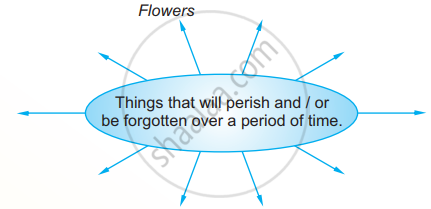Advertisements
Advertisements
Question
Look at the following picture carefully.

a) What has Time been portrayed as? Why?
b) What are the other symbols associated with Time?
Solution
(a) Time has been portrayed as a mysterious man wearing a loose cloak with a scythe in one hand and an hour-glass in other. Time is shown to have been fleeting fast. Time is the greatest conqueror.
(b) Tides, bubble of water, wind, sand, money, etc.
APPEARS IN
RELATED QUESTIONS
What are the things that last for centuries? List a few things around you that will survive four to five hundred years into the future.

Think of things that will perish and/or be forgotten with the passage of time.

On the basis of your understanding of Shakespeare's sonnet, answer the following question by ticking the correct option.
- The rich and powerful got ornate monuments made in order to _______________
On the basis of your understanding of Shakespeare's sonnet, answer the following question by ticking the correct option.
- The poet addresses his sonnet to ____________________________________
On the basis of your understanding of Shakespeare's sonnet, answer the following question by ticking the correct option.
- In the line 'The living record of your memory', living record refers to ____________
On the basis of your understanding of Shakespeare's sonnet, answer the following question by ticking the correct option.
The poem is set in _____________________
Answer the following question briefly.
Describe how the monuments and statues brave the ravages of time.
Answer the following question briefly.
Why does the poet refer to Time as being sluttish ?
Shakespeare's sonnet has been divided into three quatrains of four lines, each followed by a rhyming couplet. Each quatrain is a unit of meaning. Read the poem carefully and complete the following table on the structure of the poem.
| Rhyme scheme | Theme | |
| Quatrain 1 | Comparison between poetry and monuments. | |
| Quatrain 2 | Ravages of time on monuments contrasted with _______________ |
|
| Quatrain 3 | The recorded memory of ____________________posterity | |
| Couplet | Poetry immortalises friend |
In “Not Marble, nor the Gilded Monuments”, how does the poet justify that his verse will live on forever ?
